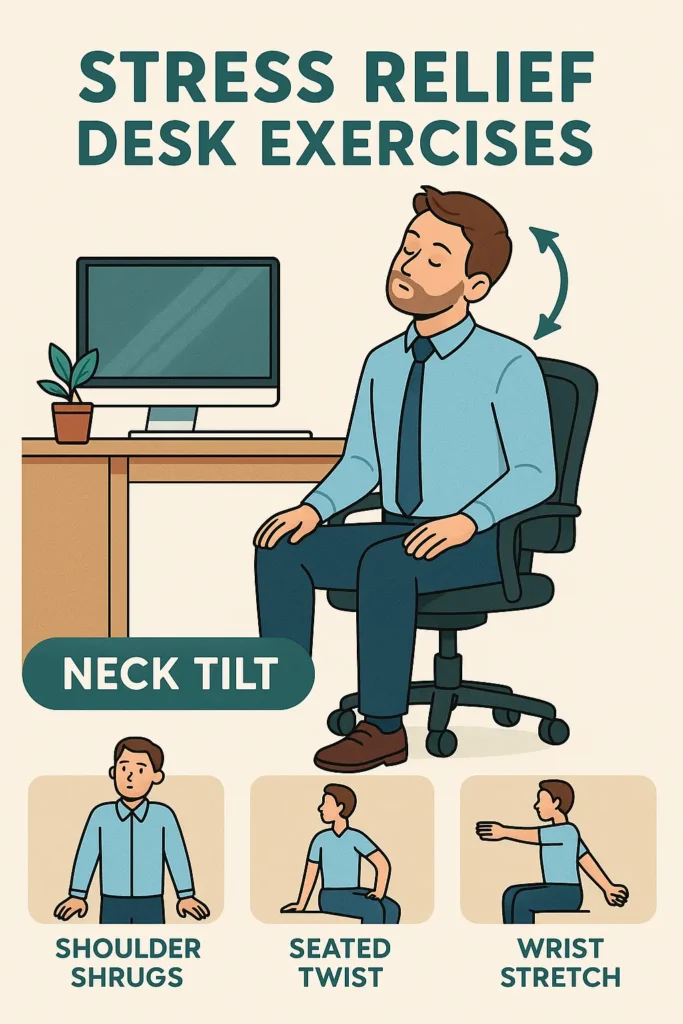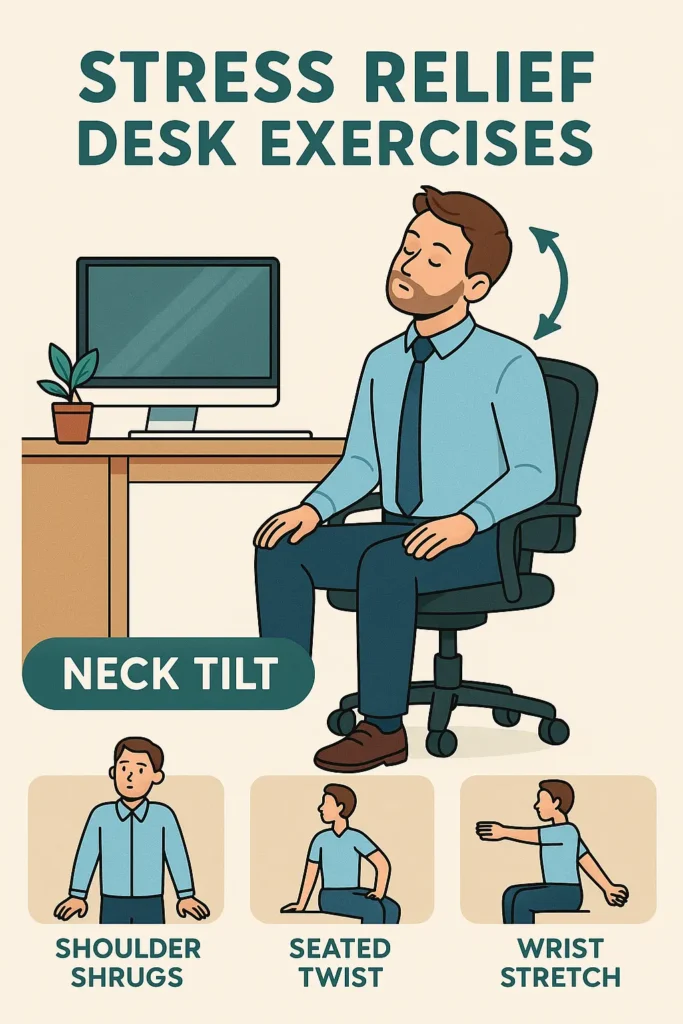Your shoulders feel like concrete, the clock creeps past 3 p.m., and your brain is slowing to a crawl. You can’t leave your workstation, yet every muscle begs for mercy. Sound familiar? You’re not alone. Modern office life chains you to a chair and showers you with deadlines, spiking cortisol and knotting your neck until the “Sunday Scaries” show up on Wednesday. The solution isn’t an expensive massage or a long gym session; it’s a series of stress relief desk exercises you can complete in under ten minutes—without drawing stares from co-workers.
This deep-dive guide arms you with evidence-based stretches, breathing drills, and micro-habits so you can melt tension, sharpen focus, and keep pain away—all while hitting your targets. Bookmark it, print the cheat sheet, and start reclaiming comfort today.
Why Desk Stretches Matter for Office Stress Relief
Sedentary Strain Raises Stress Hormones
Your body was designed to roam plains, not spreadsheets. When you sit more than six hours a day, circulating cortisol rises up to 15 percent, and your posture collapses into a C-curve that compresses discs and stifles lung capacity (Journal of Occupational Health, 2024). A two-minute stretch break can reverse that chemical surge and revive oxygen flow—no squats required.
Movement Breaks Boost Productivity (stress relief desk exercises)
Harvard Business Review tracked knowledge workers using posture sensors and found that those who took 5-minute micro-breaks every hour improved working-memory scores by 13 percent and finished priority tasks 11 percent faster. Translation: moving a little helps you crush the big stuff.
Stretching Lifts Mood & Lowers Pain
Gentle mobility drills stimulate the vagus nerve, activating your parasympathetic “rest-and-digest” system. Heart-rate variability climbs, blood pressure dips, and your brain gets the green light to produce serotonin—the calm-your-nerves neurotransmitter.

stress relief desk exercises
The Science Behind Stress Relief Desk Exercises
Muscle Tension vs. Parasympathetic Activation
Tense traps and tight hip flexors signal threat to your nervous system. Slow, controlled stretching sends the opposite message: you’re safe. In a 2023 Journal of Applied Physiology study, office workers who performed three seated stretches hourly saw a 10-beat-per-minute drop in heart rate after two weeks—mirroring the effect of a short walk.
Blood Flow Fuels Brainpower
Every time you pump your ankles or squeeze your shoulder blades, you propel stagnant blood back toward the heart and—crucially—the brain. Cerebral circulation spikes, delivering glucose and oxygen that clear your mental fog. Think of it as a shot of espresso without the jitters.
10-Minute Stress Relief Desk Exercise Routine
Below is a complete circuit. Perform the moves sequentially or sprinkle them through your day. All you need is a chair, a sturdy desk edge, and the will to pause emails for a moment.
| H4 – Exercise | How To | Duration | Primary Benefit |
|---|---|---|---|
| Neck Tilt & Hold | Sit tall, drop right ear to right shoulder, left arm reaches toward floor. Hold 15 sec—switch sides. | 1 min | Releases upper-trap knots, eases tension headaches |
| Seated Cat–Cow | Hands on knees, inhale: arch spine & lift chest; exhale: round back & tuck chin. Repeat slowly. | 2 min | Mobilizes thoracic & lumbar spine, improves breathing capacity |
| Shoulder-Blade Squeeze | Sit upright, elbows at 90°, pinch shoulder blades for 2 sec, release. 10 reps. | 1 min | Counteracts slouch, activates postural muscles |
| Wrist Flexor Stretch | Extend right arm, palm down, gently pull fingers toward you with left hand. 20 sec each side. | 1 min | Fights carpal-tunnel strain & typing fatigue |
| Ankle Alphabet | Lift right foot, trace A-Z with toes. Switch feet. | 2 min | Boosts lower-limb circulation, prevents swelling |
| Seated Figure-4 Hip Opener | Cross right ankle over left knee, hinge forward until you feel a glute stretch. 30 sec each side. | 2 min | Releases hip flexor tightness that triggers low-back pain |
| Eye-Strain 20-20-20 | Every 20 min, look 20 ft away for 20 sec. Blink gently. | 1 min (spaced) | Hydrates eyes, reduces digital fatigue |
Pro Tip: Pair each stretch with a sip of water—hydration amplifies joint lubrication and builds the habit loop: alarm → stretch → sip. (stress relief desk exercises)
Desk-Friendly Breathing & Mindfulness Drills
Not every stressor shows up in your muscles; some camp in your mind. Use these stealth tactics:
- Box Breathing (4-4-4-4): Inhale 4 sec, hold 4 sec, exhale 4 sec, hold 4 sec. Repeat for one minute to slow heart rate.
- Shoulder-Drop Exhale: Inhale and shrug shoulders to ears; exhale forcefully through mouth while letting shoulders fall. Instant relaxation cue.
- Two-Minute Body Scan: Close your eyes, move attention from crown to toes, noting sensations without judgment. Stanford Mindfulness Lab found this short scan lowers perceived stress by 22 percent.
Snack Smart: Fuel That Calms Your Nerves (stress relief desk exercises)
A racing mind often hides behind crashing blood sugar. Keep an anti-stress stash in your drawer.
Recipe Table: Calm-Crunch Trail Mix
| Ingredient | Portion | Stress-Fighting Power |
|---|---|---|
| Raw almonds | ¼ cup | Magnesium relaxes muscles & nerves |
| Pumpkin seeds | 2 Tbsp | Tryptophan, precursor to serotonin |
| Dried tart cherries | 2 Tbsp | Natural melatonin balances sleep cycle |
| 70 % dark chocolate chips | 1 Tbsp | Flavanols drop cortisol levels |
| Unsweetened coconut flakes | 1 Tbsp | Healthy fats deliver sustained energy |
Assembly: Toss ingredients, portion into ¼-cup snack bags. One serving = ~180 calories.

stress relief desk exercises
How to Build a Habit of Hourly Desk Stretching
Creating change requires more than good intentions—use behavioral science.
Set Tech Reminders
- Pomodoro Timer: Work 25 min, stretch 5 min.
- Calendar Nudges: Schedule “Move!” events in Outlook or Google.
- Smartwatch Alerts: Most devices buzz if you sit too long—turn them on.
Pairing Technique
Attach a stretch to a routine task: hit Send on an email → perform a shoulder roll. Finish a Zoom call → do a wrist flexor stretch. Consistency > intensity.
Ergonomic Audit
- Monitor Height: Top third at eye level prevents neck crane.
- Chair Setup: Hips slightly higher than knees; add lumbar support cushion.
- Keyboard & Mouse: Keep elbows at 90 °, wrists neutral.
- Stress Relief Desk Exercises
Frequently Asked Questions: Stress Relief Desk Exercises
What are stress-relief desk exercises?
They’re quick, low-impact stretches or movements you perform right at your workstation to loosen muscles, lower stress, and refresh focus—no equipment, no sweat required.
How often should I stretch at work?
Aim for 2–3 minutes every 30–60 minutes. Even a single neck tilt can reset posture if you’re slammed with meetings.
Will these moves fix chronic back pain?
They relieve muscular tension; however, persistent or sharp pain deserves a physical-therapy assessment. Think of desk stretches as prevention plus light therapy, not a cure-all.
Do I need special gear?
Nope. A supportive chair and the edge of your desk double as props. If you have a resistance band, anchor it to the desk leg for extra shoulder work.
Can desk exercises improve mental focus?
Absolutely. Studies tie micro-movement breaks to better cognitive speed and fewer errors—the brain loves oxygen.
Conclusion: Small Moves, Massive Relief stress relief desk exercises
You don’t need an hour-long yoga class to unwind tight shoulders or clear brain fog. By sprinkling these stress-relief desk exercises through your day, you shift from tension to traction—delivering projects faster, with fewer aches and more headspace.
Start now: Set a 30-minute timer, perform the Neck Tilt, and savor the release. Then tell a colleague and create an accountability duo. Your spine, deadlines, and peace of mind will thank you.
Call to Action: Tried the routine? Drop a comment below with your favorite stretch—or tag us on our social media showing your desk-stretch selfie. Let’s build a movement-minded workspace together!



One Response
Good articlegghghg